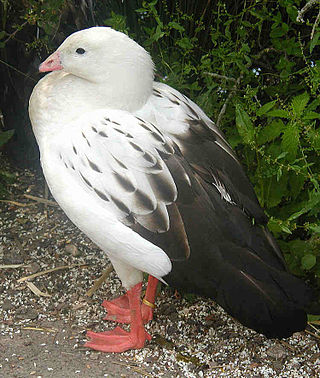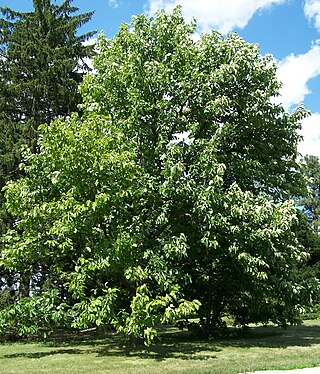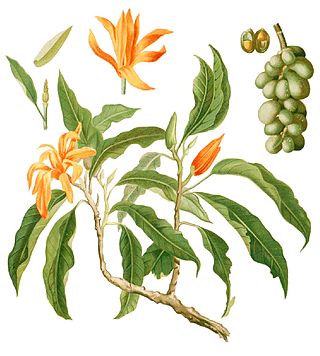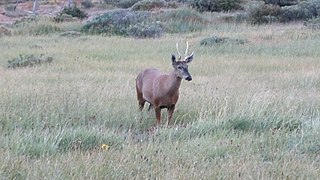
The Andean goose is a species of waterfowl in tribe Tadornini of subfamily Anserinae. It is found in Argentina, Bolivia, Chile, and Peru.

The Andean condor is a giant South American Cathartid vulture and is the only member of the genus Vultur. Found in the Andes mountains and adjacent Pacific coasts of western South America, the Andean condor is the largest flying bird in the world by combined measurement of weight and wingspan. It has a maximum wingspan of 3.3 m and weight of 15 kg (33 lb). It is generally considered as the largest bird of prey in the world.

Magnolia acuminata, commonly called the cucumber tree, cucumber magnolia or blue magnolia, is one of the largest magnolias, and one of the cold-hardiest. It is a large forest tree of the Eastern United States and Southern Ontario in Canada. It is a tree that tends to occur singly as scattered specimens, rather than in groves.

Magnolia virginiana, most commonly known as sweetbay magnolia, or merely sweetbay, is a member of the magnolia family, Magnoliaceae. It was the first magnolia to be scientifically described under modern rules of botanical nomenclature, and is the type species of the genus Magnolia; as Magnolia is also the type genus of all flowering plants (magnoliophytes), this species in a sense typifies all flowering plants.

Magnolia tripetala, commonly called umbrella magnolia or simply umbrella-tree, is a deciduous tree native to the eastern United States in the Appalachian Mountains, the Ozarks, and the Ouachita Mountains. The name "umbrella tree" derives from the fact that the large leaves are clustered at the tips of the branches forming an umbrella-shaped structure.

The Andean mountain cat is a small wild cat native to the high Andes that has been listed as Endangered on the IUCN Red List because fewer than 1,500 individuals are thought to exist in the wild. It is traditionally considered a sacred animal by indigenous Aymara and Quechua people.

The Andean tinamou is a tinamou, found commonly in high-altitude shrubland, in the Andes of South America.

Magnolia champaca, known in English as champak, is a large evergreen tree in the family Magnoliaceae. It was previously classified as Michelia champaca. It is known for its fragrant flowers, and its timber used in woodworking.

The south Andean deer, also known as the southern guemal, south Andean huemul, southern huemul, or Chilean huemul or güemul, is an endangered species of deer native to the mountains of Argentina and Chile. Along with the northern guemal or taruca, it is one of the two mid-sized deer in the Hippocamelus genus and ranges across the high mountainsides and cold valleys of the Andes. The distribution and habitat, behaviour, and diet of the deer have all been the subject of study. The viability of the small remaining population is an outstanding concern to researchers.
The Bogotá sunangel is a species of hummingbird that is only known from one specimen. The hummingbird is a bright purple with black flight feathers and a bright green chin and crown. This bird has only been found in Colombia and is assumed to live in cloud forest between 1200 and 3400 meters. Most of its potential habitat is degraded, though it is feasible that a population may still exist.

Rhinella poeppigii is a species of toad in the family Bufonidae that is known from the eastern Andean slopes of Ecuador, Peru, and Bolivia, as well as from Serranía de Sira in Amazonian Peru. Its distinctiveness from Rhinella marina has been debated, but it is currently accepted as a valid species. It is named after Eduard Friedrich Poeppig, German botanist and naturalist who made scientific expeditions to South America.

The Andean gull is a species in subfamily Larinae of the family Laridae, the gulls, terns, and skimmers. It is found in Argentina, Bolivia, Chile, Colombia, Ecuador, and Peru.

The Andean flicker is a species of bird in subfamily Picinae of the woodpecker family Picidae. It is found in Argentina, Bolivia, Chile, Ecuador, and Peru.
Magnolia boliviana is a tree in the family Magnoliaceae native to the rainforests of the eastern Andean foothills of Bolivia.
Magnolia henaoi is a species of flowering plant in the family Magnoliaceae. It is endemic to Colombia, where it is known from only two locations. It is known commonly as hojarasco de Henao. It is an uncommon part of the canopy of sub-Andean forest habitat. It is threatened by overcollection for its wood.
Magnolia neillii is a species of plant in the family Magnoliaceae. It is endemic to Ecuador. Its natural habitat is subtropical or tropical moist lowland forests. If the Magnolia family is treated as consisting of a large number of smaller genera, then this species is placed in genus Talauma. In modern literature, it is customary to treat Magnolia as one large genus, and in that case, this species is treated as belonging to section Talauma in subgenus Magnolia.

Llanganates National Park is a protected area in Ecuador situated in the Cotopaxi Province, Napo Province, Pastaza Province and Tungurahua Province. Located within the park is Cerro Hermoso, a 4570 meter high peak that is a popular hiking destination. The park is famous for the Treasure of the Llanganatis.

Magnolia liliifera, commonly known as egg magnolia, is a flowering tree native to the Indomalayan realm. It bears white to cream-colored flowers on terminal stems. The leaves are elliptical and get as large as 25 cm (10 in) long and 8 cm (3 in) wide. The tree ranges in height from 3.5 to 18.5 m in situ.

The Andean tapeti or Andean cottontail is a species of cottontail rabbit native to Colombia, Venezuela, Peru and Ecuador. It was previously considered a subspecies of the common tapeti. Living at high elevations in the treeless Páramo of the Andes, analysis in 2017 confirmed that it is sufficiently distinct in both appearance and genetics to be considered a species in its own right. Although widespread, it remains poorly known, as few studies have been conducted on its biology and habits as distinct from those of the tapeti
















